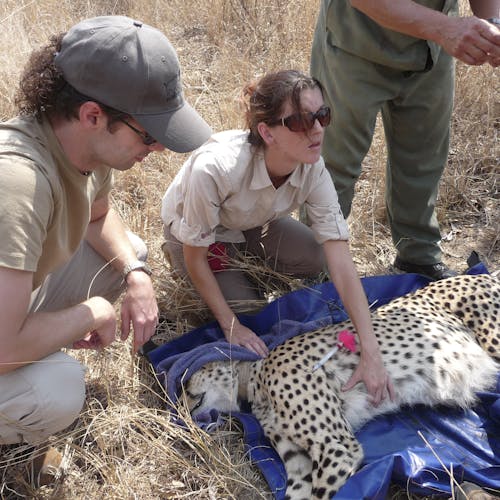
Shimongwe volunteers Amy and Allison get up close to cheetah!
Two weeks into our trip, we once again found ourselves on the plains of Phinda Wildlife Research Project. Wildebeest and zebra were surrounding us, so we were all surprised when a team member called out “cheetah” and pointed into the distance. This was followed by 125 points – the reward of spotting a cheetah in our animal safari game. We all raced to get out our binoculars and scan the horizon for the animal.
After some careful guidance, we too saw the cheetah, lying down in the scrub nearly 300 metres away, perfectly camouflaged. Excited at the discovery and hopeful that the cheetah may be the one that had been eluding the team for three weeks, we quietly approached in the car. Stopping within 10 metres of the cat, we were all taken aback by the beauty of the animal…until it got up and started to walk.
The moment it got up, we immediately saw a problem with its left back paw, which worsened as it limped up onto a mound. Realising this was the animal we were after, as a suspected bovine tuberculosis (TB) case, we circled inwards to get a better look. This is when we realised two cheetahs were sitting there.
The reason the injured cheetah had survived this long was down to his brother, who had been providing food and protection. Unwilling to scare the brother off, in case he didn’t come back, the team decided to dart both cheetahs. We then invited the cheetah researcher to take advantage of the situation and get the data that they needed. The darts went in fairly easily, with the injured cheetah staying close to its asleep brother until it too was darted. After moving them into the shade, the volunteers gave them penicillin and vitamins to help them recover when they came around.
We set about the examination, taking blood and getting everything else done first, before looking at the obvious swelling. Blood and extensive measuring were done on both cheetahs, as well as information collected for the research project, finishing with ear notching and micro-chipping used for identification.
All the work was done with minimum movement, due to the cat's sensitivity to grass rustling, which allowed the volunteers to really examine and ask questions about the animals. After the work was done, we examined the injured point and the nature of the swelling. Because it was localised and not attached to the foot, we were reassured it was not TB. To confirm this diagnosis, we took a smear sample and drained some fluid before giving the cheetah a concoction of anti-inflammatories, antibiotics, and painkillers to assist with the recovery.
We all retreated to the truck, drove a short way, and gave a reversal drug to wake them up. Both cheetahs woke up within moments, and after initial confusion, they both got up and started walking. The injured cheetah was now walking instead of limping, giving a very encouraging start to recovery. As the cheetahs walked, they started ‘chirping’ and calling for their sister – a surprising noise from such an animal, but very cute nonetheless.
The whole experience was once-in-a-lifetime and incredibly intimate. We all got to see and learn an incredible amount, get some great photos, and it was certainly the best experience of the trip. It showed us to always expect the unexpected.
Cheetah and leopard populations are unique as they are very hard to contain within a reserve, meaning most populations occur outside of the reserves. Both cat species can get through game-proof fences, resulting in a greater risk of human conflict, which can be lethal for the animals. This increases their chances of getting injured, making it vital to have wildlife veterinarians in the area. Veterinary work is essential to the preservation and protection of rare and endangered species endemic to Africa.
The veterinary volunteers join in the day-to-day activities of a wildlife veterinarian in the field, as well as assisting with the treatment and physical handling of animals. The vet is also hand-rearing two orphan rhinos – Mkombe and Nyoni.
Shimongwe Veterinary Experience is ideal for current and prospective veterinary students. The vets work closely alongside the Phinda research team, allowing volunteers to work with the ‘Big 5’.
If you are passionate about conservation research, you may also be interested in volunteering at Phinda Wildlife Research Project, based on the reserve where the cheetahs mentioned in the story above were found.
Phinda Game Reserve has a research team looking at various aspects of southern African wildlife. They are also involved with cheetah, rhino, elephant, and leopard monitoring, which includes tracking and darting individuals for data collection. All of the work – both research and veterinary – that occurs within Phinda Game Reserve is necessary for the conservation of southern Africa’s wildlife, which depends on hard-working volunteers.
Allison Besser and Amy Powdrill, Volunteers at Shimongwe Veterinary Experience, August 2010
